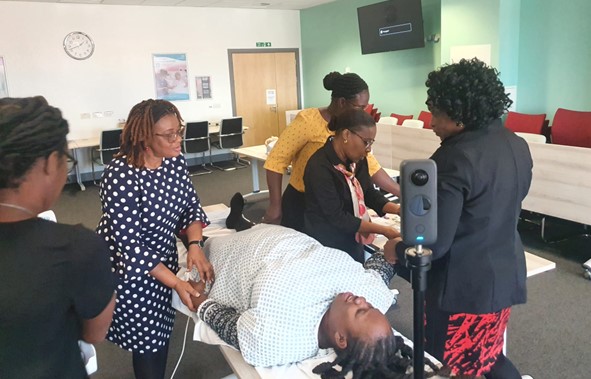Richard Price, January 2023

Visiting nurses from the Caribbean nation of Saint Vincent and the Grenadines (SVG) were supported by HEE to complete a 6-week placement in the NHS, developing their skills in mental health, emergency care and leadership. This work, which was part of a mutual learning exchange programme (Fellowship programme), included a visit from the chief nurse of SVG and a team of 5 experienced nurses.
The nurses were hosted by Leeds Teaching Hospitals, based at St James’ Hospital in Leeds, where they were given the opportunity to explore the NHS and learn how clinical interventions were performed, as well as immersing themselves in British culture.
As well as clinical observations, the nursing team were invited by the TEL team to attend a full day TEL workshop, designed to share knowledge about educational technologies and techniques from the UK. The workshop was designed so that the visiting nurses could learn about TEL and embed it into their own nurse education programme when they returned home.
I had the huge privilege of working with the nurses during the workshop and supporting them to develop their skills in TEL, along with another colleague from TEL, James Drinkall. We worked with the nurses to experiment with and explore TEL’s virtual and augmented reality headsets and to look at some of the other tools and technologies we use in the UK to train NHS nurses. We also had a lot of fun in the process! The augmented reality t-shirts were a huge hit with our guest nurses and they could see lots of applications of the technology with their early-career and trainee nurses.


The afternoon session was framed around the production of a 360-degree video for education, to teach participants how to design, film and produce a video, as well as creating a resource that can be used in teaching. 360-degree video is a form of immersive technology where a 360 camera captures all angles of a scenario, outputting a video that can be displayed on a virtual reality headset. 360-degree video works well on mobile devices (as well as virtual reality headsets) and is achievable and sustainable without extensive investment, so has the potential to be of value where resources and access to equipment are limited.
The participants planned and filmed a mental health scenario using themselves as actors and readily available equipment from the NHS trust, such as gowns and gloves. As we didn’t have access to a simulation suite or real ward, the meeting room became a makeshift ward, with the nurses recreating their own ward environment using the equipment available.

Participants were overwhelmingly positive about the day and have a video resource they can use in future nurse teaching in SVG. The nurses have also learned the skills needed to be able to produce their own 360-degree videos in the future. This approach to training is one which we are going to use again when other nurse and clinical fellows visit the UK.
